
How Will MAP Measure the Basic Cosmological Parameters?

Because MAP will be able to measure the microwave background fluctuations to tremendous accuracy with minimal systematic errors accross a wide range of
angular scales, it should be able to accurately determine most of the basic parameters of cosmology. By answering many of the current open questions in cosmology, it will
likely point astrophysicists towards newer and deeper questions.
In order to understand how MAP will determine cosmological parameters, we will need to describe both the physical evolution of density fluctuations in the early universe and how cosmologists describe the statistical properties of the microwave background.

The History of the Universe
The big bang theory implies that the early universe was hot and dense.
During the first three hundred thousand years of the big bang, the temperature
of the universe exceeded 4000 K (7000 F), so most of the hydrogen
in the universe was ionized. Thus, the early universe was a hot sea of
protons and electrons. Since photons scatter off of the free electrons, the
photons, electrons and protons are tightly tied together and behave
as a single fluid.
When the temperature of the universe dropped below 4000 K, the electrons
and protons combined to make hydrogen. Hydrogen is almost completely transparent
to the cosmic background radiation, thus, the photons can now propogate freely
through the universe. The appearance of the sky on cloudy day
is a good analogy to the appearance of the microwave background radiation.
Water droplets scatter optical light, much like the free electrons scatter
the cosmic background radiation. Water vapor is nearly transparent to optical
light, just as neutral hydrogen is nearly transparent to the cosmic
background radiation. On a cloudy day, we can look out through the atmosphere
to the water droplets that make up the surface of the clouds. When COBE
(and eventually MAP) observes microwave background sky it looks back to when
there were free electrons that could readily scatter cosmic background radiation.
This cosmic background "cloud surface" is called the "surface of last scatter"
Thus, observations of the cosmic background radiation directly probe the
physical conditions at this epoch, only three hundred thousand years after the
big bang.
Evolution of Density Fluctuations
The
Microwave Background Fluctuation Spectrum
There are a number of effects that can produce temperature variations in the microwave
background: variations in the density of the universe at the surface of last scatter, the velocity of the electron-photon fluid, variations in the gravitational potential
of the universe at the surface of last scatter as well as variations in the gravitational potential along the photon path. As we will see different physical phenomenum are responsible for each of these effects so that by studying the microwave background fluctuations, we can infer a wealth of information about the early universe.
Cosmologists find that it is convienent to represent the fluctuations in terms of
an "angular fluctuation spectrum", which plots the amplitude of temperature fluctuation
as a function of angular wave number l. Such a plot is shown below for the standard
cold dark matter model in a flat universe.
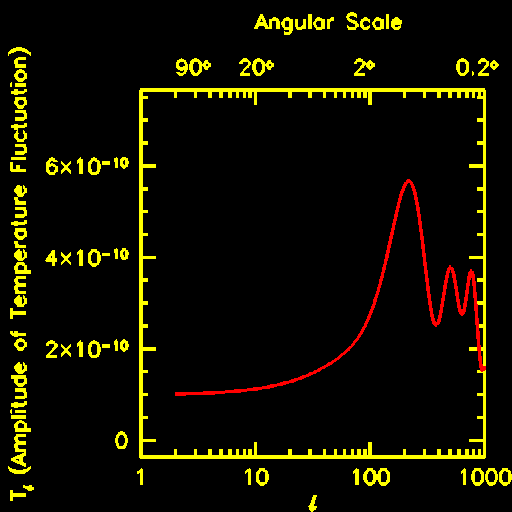
The temperature fluctuations are expected to be largest on the angular scale
of roughly one degree. This scale corresponds to the angle subtended by the
"sonic horizon", the distance that a sound wave moves from the
beginning of the big bang to when hydrogen recombination occurs. This distance
serves as a ruler for measuring the geometry of the universe.
Measuring the Geometry of the Universe
In a flat universe, the dominant angular scale for microwave background fluctuations,
the angle subtended by the sonic horizon at the surface of last scatter is roughly 1 degree.
In our temperature fluctuation spectrum, this corresponds to l = 180. If the universe is
open, photons move on more rapidly diverging paths in negatively curved space. Due
to this effect, the dominant angular scale for microwave shifts to smaller angular scales
(and hence larger l).
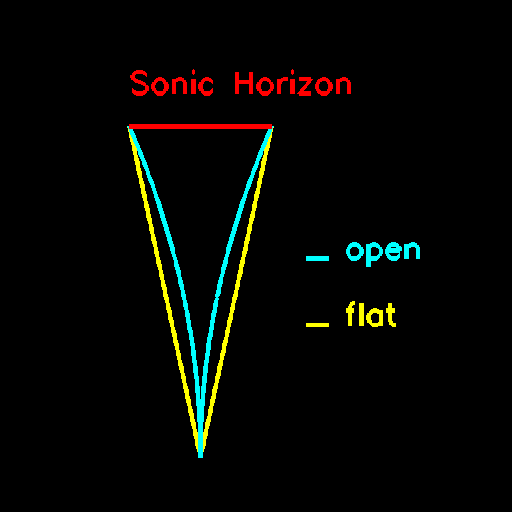
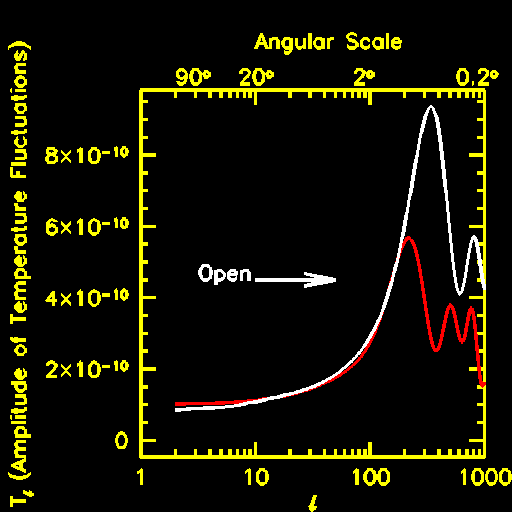
Counting the Number of Electrons in the Universe
The behaviour of the early universe fluid will also depend upon the relative number
densities of electrons and photons. The more electrons (and protons), the stronger
their response to the gravitational potential wells. This leads to an enhancement of
the first and third acoustic peaks, which are produced by the fluid falling into the
potential wells and a suppresion of the second acoustic peak, which is produced by the
fluid moving outward. Thus, by measuring the relative heights of the peaks in the
fluctuation spectrum, we should be able to determine the relative number density of
protons and electrons.
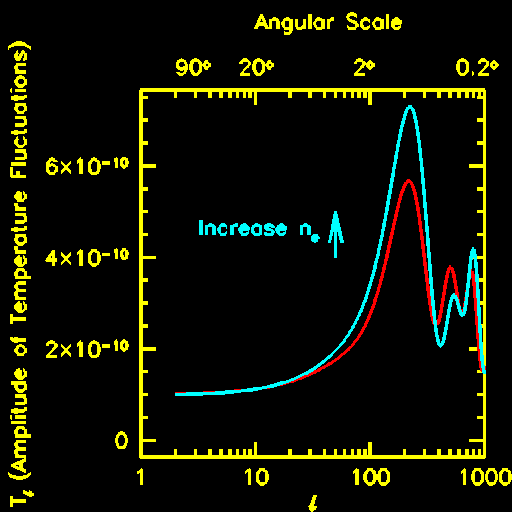
Increasing the ratio of electrons to photons also has the effect of decreasing the
sound speed of the fluid. Since the fluid moves more slowly, the secondary oscillations
occur at larger angular scales. This effect shifts the location of the latter peaks in
the fluctuation spectrum.
Measuring the Matter Content of the Universe
The cosmic background radiation propogating from the surface of last scatter to our experiment is also affected by gravitational fluctuations along its path. Photons falling
into the gravitational potential wells of clusters gain energy. They lose this energy when they climb out of the potential wells. If the universe is flat and composed
entirely of matter, then these two effects cancel exactly and the matter along the photon
path has no net gravitational effect.
If there is a cosmological constant, then the depth of gravitational potential wells
decay with time. Thus, a photon which falls into a deep potential well gets to climb
out of a slightly shallower well. The net effect leads to a slight increase in
photon energy along this path. Another photon which travels through a low density
region (which produces a potential "hill") will lose energy as it gets to descend down a shallower hill than it climbed up. Because of this effect, a model with a cosmological constant will have additional fluctuations on large angular scales. Large angular scale measurements are most senstive to variations in the gravitational potential at low
redshift.
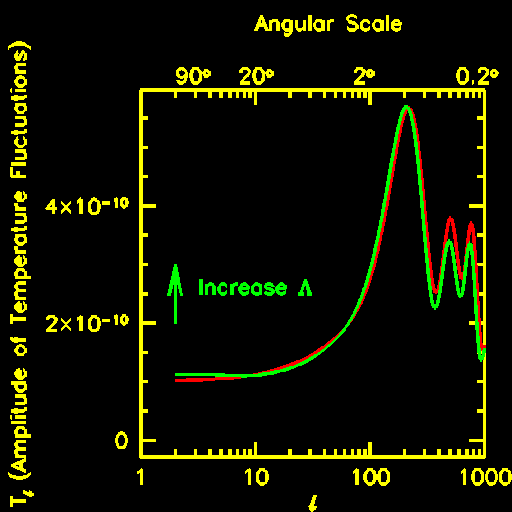
There is a similar effect operating at high redshift (z ~ 500 - 1300): during
this epoch, photons and neutrinos make a significant contribution to the total energy
density of the universe. Because of this contribution, gravitational potential
fluctuations also decay during period. This leads to enhanced fluctuations on angular
scales smaller than approximately two degrees. This is the angular scale
subtended by the horizon at z ~ 500. The larger the ratio of photon energy density to
matter density, the more important role radiation plays during this epoch and the higher
amplitude of temperature fluctuations. Since the FIRAS measurements of the spectrum
have already determined the photon energy density, we can use the measurement of the amplitude of fluctuations on this angular scale to determine the matter energy density.
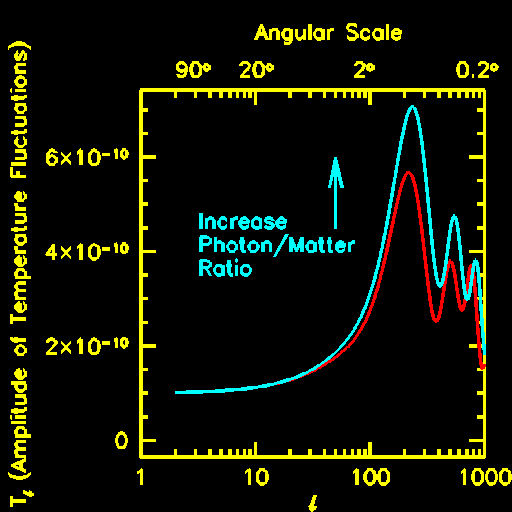
Microwave Background Polarization: Another Window into the Early Universe
MAP measures not only temperature fluctuations in the microwave background, but also
the polarization of the microwave background. While no one has yet detected microwave background polarization, our theoretical models predict that it should exist at an
amplitude detectable with MAP's sensitivities.
Scattered light, whether it is sunlight reflected off of haze, or microwave background photons that are reflected off of free electrons in the early universe is often polarized.
This effect occurs because the electron-photon scattering cross-section depends upon
the polarization of the incoming photon (which corresponds to the direction of the photon electric field). Because of this effect, we can probe the properties of the electrons that
the photon encounters as it propogates from the surface of last scatter to our
experiment.
At this point in the discussion, the astute reader might object, "but wait, I thought
that there were no free electrons left once the universe cooled below 4000 K".
Fortunately, this is not true. Once stars start forming their radiation will
be able to ionize hydrogen, thus liberating free electrons. These free electrons
will produce polarization fluctuations in the microwave background that
are potentially detectable.
Probing the Epoch of Star Formation
Testing the Basic Model
Cross-Correlating Temperature and Polarization Fluctuations

 Back to the Introduction to Cosmology Page
Back to the Introduction to Cosmology Page
 Back to the MAP Home Page
Back to the MAP Home Page
Please help us make this web site more useful and enjoyable by telling us what you
would like to see at this site:
 David N. Spergel / dns@astro.princeton.edu
David N. Spergel / dns@astro.princeton.edu
Gary Hinshaw / hinshaw@stars.gsfc.nasa.gov
Charles L. Bennett / bennett@stars.gsfc.nasa.gov
Last updated: April 7, 1997










 Back to the Introduction to Cosmology Page
Back to the Introduction to Cosmology Page
 Back to the MAP Home Page
Back to the MAP Home Page
 David N. Spergel / dns@astro.princeton.edu
David N. Spergel / dns@astro.princeton.edu